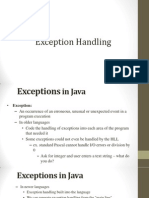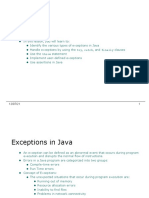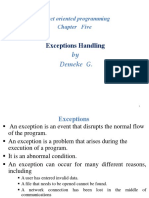0% found this document useful (0 votes)
44 views26 pagesLecture 9 - Package and Exception Handling
The document provides an overview of Java packages and exception handling, detailing how to create and use packages, as well as the importance of managing exceptions in Java programs. It explains the structure of try, catch, and finally blocks, and distinguishes between checked and unchecked exceptions. Additionally, it covers how to create custom exception classes and the significance of maintaining program flow despite unexpected events.
Uploaded by
dogiathuyasd18Copyright
© © All Rights Reserved
We take content rights seriously. If you suspect this is your content, claim it here.
Available Formats
Download as PDF, TXT or read online on Scribd
0% found this document useful (0 votes)
44 views26 pagesLecture 9 - Package and Exception Handling
The document provides an overview of Java packages and exception handling, detailing how to create and use packages, as well as the importance of managing exceptions in Java programs. It explains the structure of try, catch, and finally blocks, and distinguishes between checked and unchecked exceptions. Additionally, it covers how to create custom exception classes and the significance of maintaining program flow despite unexpected events.
Uploaded by
dogiathuyasd18Copyright
© © All Rights Reserved
We take content rights seriously. If you suspect this is your content, claim it here.
Available Formats
Download as PDF, TXT or read online on Scribd
/ 26




















































































